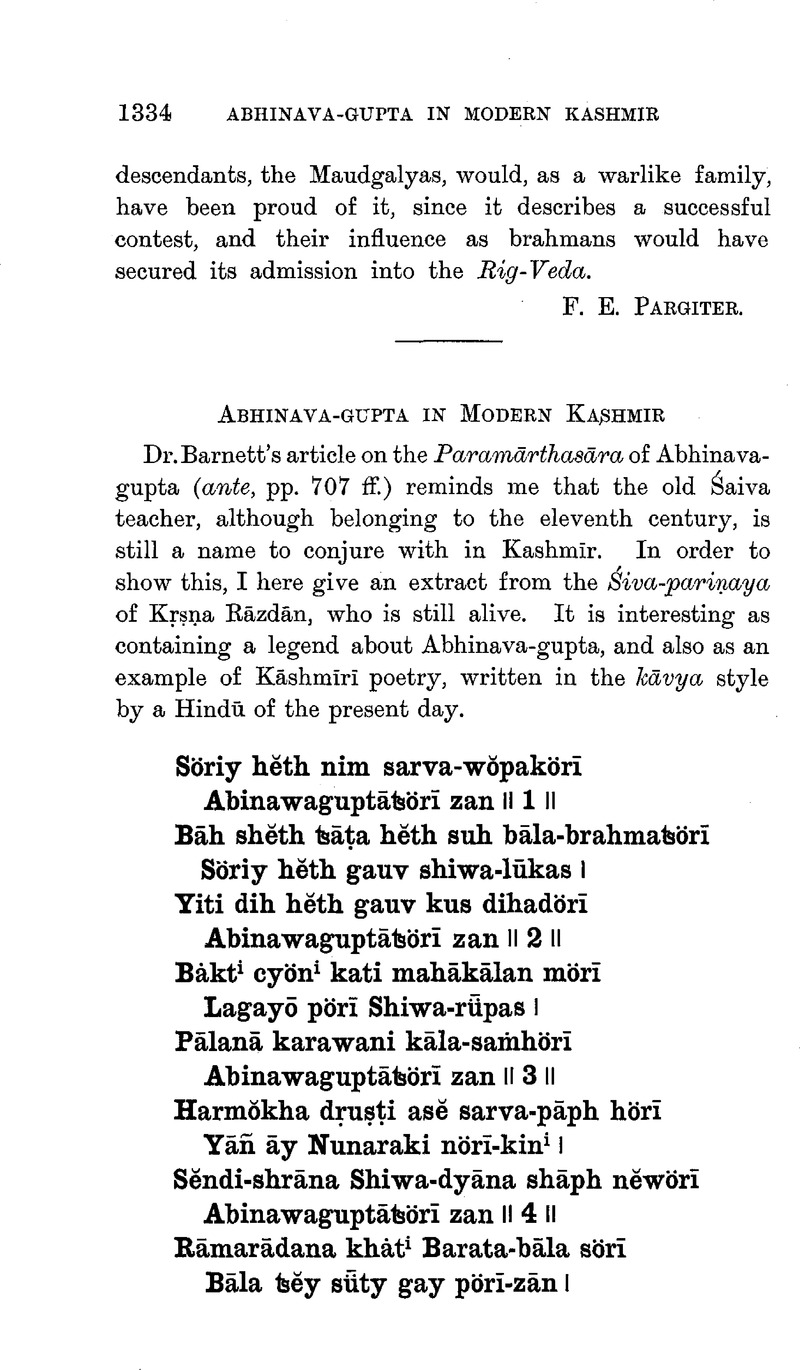No CrossRef data available.
Published online by Cambridge University Press: 15 March 2011

page 1336 note 1 The legend runs that Abhinava-gupta took twelve hundred disciples into a cave, and ascended with them thence, in his own bodily form, to Śiva-lōka. The cave is still shown near Bīrū, the ancient Bahurūpa, about 13 miles to the south-west of Śrīnagar.
page 1336 note 2 Here, and in the following verses, there is an elaborate series of double meanings. Harmokh (Haramukha) is a well-known mountain in Kashmīr, sacred to Śiva, and the goal of a famous pilgrimage. The word also means “the totality of all things”. Nunar is a village on the pilgrim route to Haramukha, and also means “the carotid artery” (suṣumnā-nāḍī), through which the soul passes on its exit at the time of death. The Sindhu is a large river of Kashmir, which has to be crossed en route to Haramukha. Hence the alternative rendering is “The sight of (Śiva, who is) the totality of all things, takes away sin when a man is at the point of death, even while he is yet alive; and meditation on Him, like bathing in the Sindhu, wards off the effects of every curse”.
page 1336 note 3 At the village of Rāmarādan (Rāmārādhanā) pilgrims commence the ascent of Haramukha, going over the spur of Baruth (Bharatagiri). See Stein, , Rājataraṅgiṇī, Trans, i, 114, and ii, 408Google Scholar. At Baruth the ascent first begins to be trying, and here pilgrims sometimes fall sick, owing to the rarified atmosphere or to exhaustion, see Knowles, H., Dictionary of Kashmiri Proverbs, 233Google Scholar. Barañě-bal is the name of some bathing place on the route, which I have not identified. The verse also means, “Having worshipped Rāma and Bharata, knowledge of whom is obtained through Thee, we opened the bolts, consisting of the maṇipūra (barañě-bal), or mystic circle round the navel, of the door of thy love.”
page 1337 note 1 The Nādaběnd (nāda-bindu) is the mystic form of Śiva indicated by the half-circle and dot of the sign anunāsika, and represented by the anuswāra of the syllable ōṁ. The haṁsa-nāda, or soul-cry, is another name for the ajapā, or voiceless, mantra. The nāḍī-cakra is one of the mystic yōga symbols. The curious in such matters will find full particulars regarding it on p. 2825 of the Vācaspatya. We should expect these words to signify also certain localities on the pilgrim route, but I have not succeeded in identifying them. Brahmasar is a lake and Haṁsadwār a spur passed on the same route. Brahmasar also means the brahmarandhra, or suture in the crown of the head, through which the soul escapes at death. With this interpretation haṁsadwār would mean the doorway of the soul.
page 1337 note 2 Evidently the name of one of the many sacred lakes passed on the pilgrim route.
page 1337 note 3 The name of the pargana in which the Bīrū cave is situated.
page 1337 note 4 Thajiwôru, a site passed on the pilgrimage, is the ancient Thalyōraka (cf. Stein, op. cit., ii, 54, n., who doubtfully, and apparently incorrectly, identifies it with the modern Thyūr). The word also means “the highest place (paramapada), i.e. Śiva's heaven.
page 1338 note 1 Gaj-gāh, in Hindī, is a tasselled string made up of the tail-hairs of the Bos grwnniens, and suspended from an elephant's neck. Here gajigāh is used for the cāmara, or fly-whisk, made of the same materials, the employment of which indicates worship.